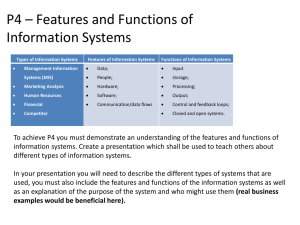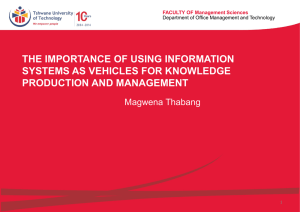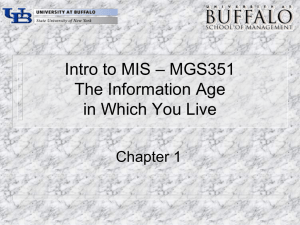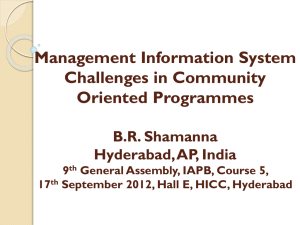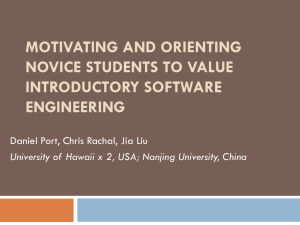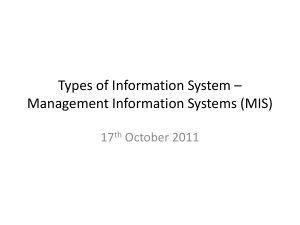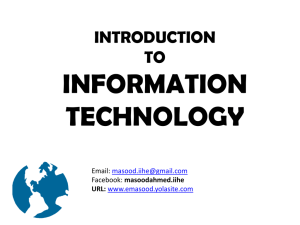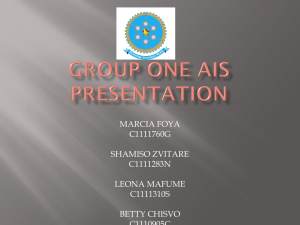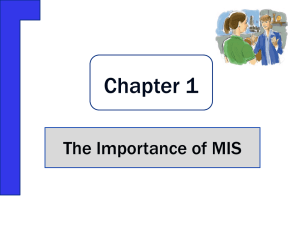Introduction to Course
advertisement
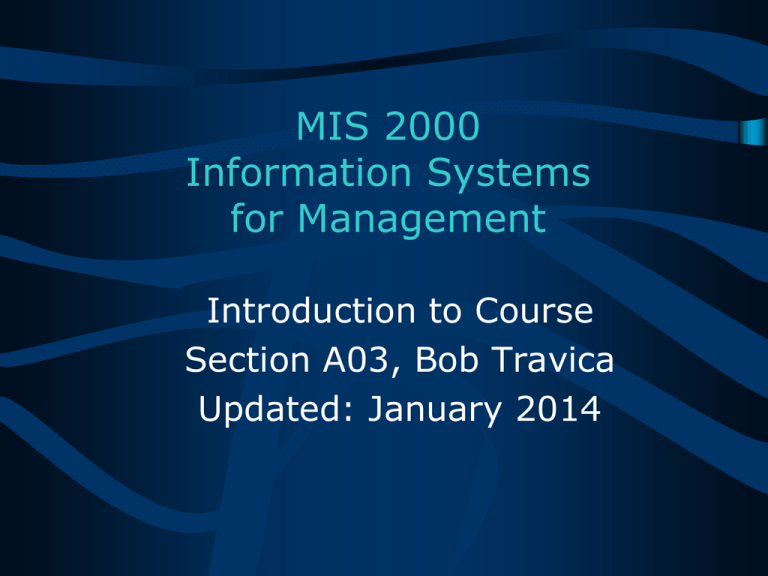
MIS 2000 Information Systems for Management Introduction to Course Section A03, Bob Travica Updated: January 2014 Outline • What is Management Information Systems (MIS)? • Focus of MIS 2000 • Course at a Glance • Teamwork • Assignments • Hands-on: Class Exercises & Labs • MIS on your resume 2 What is Management Information Systems (MIS)? • An area of management study and practice (as marketing or HRM*). • MIS focuses on managing organizational data, knowledge and information technologies (IT) in order to achieve greater efficiency (productivity) and effectiveness (accomplishment of goals). • Central concept is Information System (IS), which includes data, IT and work procedures. • The term “MIS” is historical, when the main kind of IS would record transactions and report on basic operations (e.g., payroll, inventory, sales). • Today, MIS is about any type of IS (see Syllabus for types). 3 Focus of MIS 2000 • An introductory course, with both conceptual and practical focus. • Management approach: Analyzing business (organizational) processes (BP)* in order to understand: – organizational data (in various states of organization) – BP working with organizational data – support of information systems (IS) to BP – how to improve BP by IS support • Critical thinking: Stay away from a “silver bullet” approach – a new information technology “solves all problems”! • Look at process design and performance and ask, how it can be supported with better IT and IS. • Try to see how IS and IT can improve BP in your area of study. 4 Course at a Glance • Course outline: online, paper • Study materials: No textbook, materials online & some paper handouts • Study methods: lectures, teamwork (all assignments and class activities, class exercises, labs (MS Access, Excel, SAP*), discussion • Assignments: 1. 2. 3. • Laboratory (MS Access & Excel) Three home works Two exams Class participation: talking on the topic in class (1 mark). – If you do not attend, you can’t participate. Just attending is not enough. – participating in teamwork on class exercises brings 0.5 marks. 5 Course at a Glance – Online Support • Study materials: – Concept list on your instructor’s Website – Class notes (slides) – same Website. Wait for updates, check the time stamp! – Other materials – same Website • To save and print class notes off the Web site use the procedures listed in the footer of this slide (save the printer tonner!) • UofM’s Virtual Learning Commons (doing research, writing paper, academic integrity) 6 Teamwork • Make a team of three to five members (not more!) • Specify the study area (major) if you can; not all members have to be from the same area • Elect a coordinator/spokesperson – communicates with instructor • Start planning time and responsibilities related to assignments 7 Assignments • 1. Data Analysis & Diagramming: The task is to analyze a narrative describing a business situation and to create a data diagram. • 2. Business Process Analysis & Diagramming: The task is to analyze a narrative describing a business situation and to create a process diagram. • 3. Labs will have quizzes and homeworks on MS Access or Excel.* 8 Hands-on: Class Exercises & Labs • Class exercises in teams; focus of some key aspects of the topics studied (e.g., process diagramming, decision making…) – Problem to solve as team; instructor helps – Present your work, learn from others • Laboratory training: – MS Access and MS Excel – Check schedule – Total 6 sessions; assignments and a final grade – SAP – software for enterprise level IS 9 MIS on Your Resume • Information systems support every department and most work in today’s organizations. • MIS is related to all management disciplines. • Understanding MIS makes a better accountant, marketer, HR manager, purchasing manager… • It pays back to double major with MIS! • MIS courses cover IS Strategy, databases, IS Analysis & Design, computer networks, and accounting IS. 10



